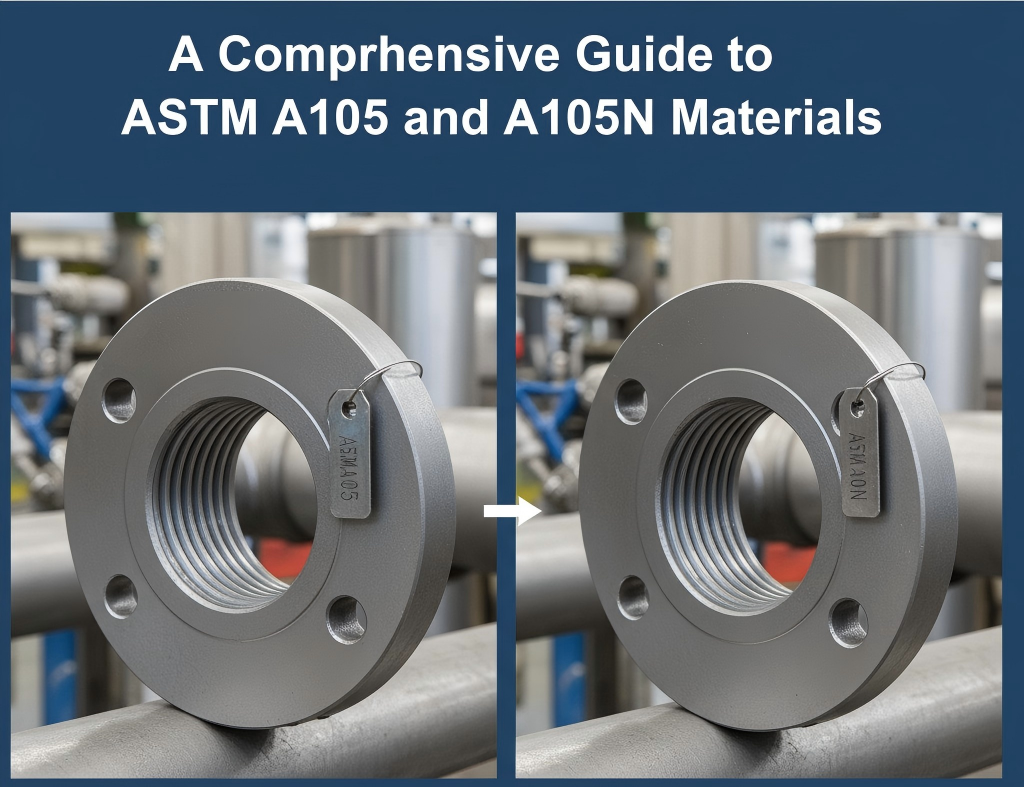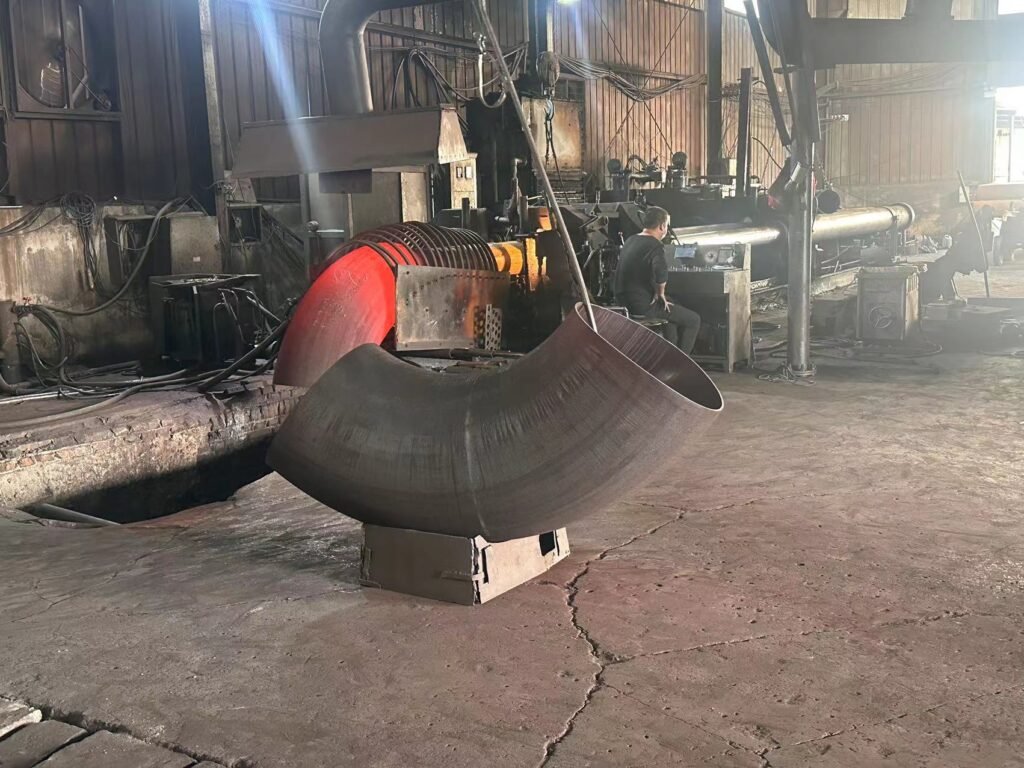Introduction
ASTM A105 and ASTM A105N are two widely used carbon steel materials in industries that demand strength, durability, and reliability. They are primarily employed in the manufacture of forged components such as flanges, fittings, and valves for piping systems. While ASTM A105 refers to the standard specification for forged carbon steel, ASTM A105N is a normalized version of this material, offering enhanced properties suitable for more demanding applications.
These materials play a crucial role across industries, from oil and gas to chemical processing, due to their excellent mechanical properties and adaptability to varying conditions. This blog will explore their chemical composition, mechanical properties, manufacturing processes, and applications, highlighting their critical role in modern infrastructure projects.
By the end of this post, you’ll have an in-depth understanding of ASTM A105 and A105N and why they continue to be essential materials in industrial and engineering applications.
What are ASTM A105 and ASTM A105N?
ASTM A105
ASTM A105 is a specification established by the American Society for Testing and Materials (ASTM) that covers forged carbon steel for piping components. This material is known for its robustness and ability to withstand high pressure and temperature environments. It’s primarily used in small-diameter pipe fittings, flanges, valves, and other components that require superior mechanical strength and toughness.
ASTM A105N
The “N” in ASTM A105N stands for “normalizing.” Normalization is a heat treatment process where the material is heated above its critical temperature and then cooled in still air. This treatment refines the grain structure of ASTM A105, enhancing its mechanical properties such as strength, toughness, and ductility. ASTM A105N is especially suitable for applications under extreme pressure, temperature, or environmental conditions, making it a preferred choice for critical piping systems across industries.
Although ASTM A105 and A105N share the same chemical composition, the normalization process in A105N results in superior mechanical properties compared to untreated A105.
Chemical Composition of ASTM A105 and A105N
Both ASTM A105 and A105N have the same chemical composition. Their formulation is carefully balanced to deliver the right combination of weldability, strength, and machinability.
| Element | Percentage |
| Carbon (C) | 0.35% (maximum) |
| Manganese (Mn) | 0.60–1.05% |
| Phosphorus (P) | 0.035% (maximum) |
| Sulfur (S) | 0.040% (maximum) |
| Silicon (Si) | 0.10–0.35% |
| Copper (Cu) | 0.40% (maximum) |
| Nickel (Ni) | 0.40% (maximum) |
| Chromium (Cr) | 0.30% (maximum) |
| Molybdenum (Mo) | 0.12% (maximum) |
| Vanadium (V) | 0.05% (maximum) |
Key Observations
The low carbon content ensures good weldability and machinabilty.
Manganese improves tensile strength and hardness.
Silicon enhances strength and resistance to oxidation.
Phosphorus and sulfur are kept to minimal levels to avoid brittleness and improve toughness.
This chemical composition makes ASTM A105 and A105N highly durable and resistant to mechanical stress, corrosion, and environmental factors.
Mechanical Properties of ASTM A105 and A105N
ASTM A105 and A105N exhibit excellent mechanical properties that make them suitable for high-pressure and high-temperature applications. These properties include tensile strength, yield strength, and ductility.
| Property | ASTM A105 | ASTM A105N |
| Tensile Strength | 485 MPa (minimum) | 485 MPa (minimum) |
| Yield Strength | 250 MPa (minimum) | 250 MPa (minimum) |
| Elongation | 22% (minimum) | 22% (minimum) |
| Hardness | 187 HB (maximum) | 187 HB (maximum) |
Key Highlights
Tensile and Yield Strength
Both grades offer high tensile and yield strength, making them apt for structural and pressure-holding applications.
Elongation
The elongation percentage ensures good ductility, which allows the material to deform without breaking under stress.
Impact Toughness
ASTM A105N shows superior impact toughness due to the normalizing process, which improves grain structure and stress resistance.
The enhanced mechanical properties of ASTM A105N make it the preferred choice for applications involving elevated temperatures and pressures.
Applications of ASTM A105 and ASTM A105N

1. Oil and Gas Industry
These materials are heavily used for flanges, fittings, and valves in oil and gas pipelines. Their ability to withstand high pressure, temperature fluctuations, and corrosive environments makes them ideal for operations both onshore and offshore.
2. Power Plants
Power generation facilities often use ASTM A105 and A105N in boiler and piping systems. They perform exceptionally well in high-temperature environments where material reliability is crucial.
3. Chemical and Petrochemical Industry

These materials find extensive use in the transportation of chemicals and other volatile substances. Their toughness and resistance to corrosion ensure safe and efficient operations.
4. Water Distribution Systems
ASTM A105 and A105N fittings are integral to water distribution networks, particularly in environments requiring long-lasting, pressure-resistant components.
5. Marine Applications
Shipbuilding and marine installations demand materials capable of performing in harsh saline environments. ASTM A105 and A105N meet these requirements with ease.
The versatility of these materials enables their use across multiple industries, where safety and performance cannot be compromised.
Manufacturing Process
The manufacturing of ASTM A105 and A105N components involves several critical steps to ensure quality and precision:
1. Forging
Raw material is heated and shaped into the desired form. Forging enhances the grain structure, resulting in improved strength and toughness.
2. Heat Treatment
ASTM A105 may undergo standard heat treatment based on application requirements.
ASTM A105N specifically undergoes normalization, which refines grain structure for improved properties.
3. Machining
Forged parts are machined to precise dimensions, ensuring conformity to industry standards like ASTM and ASME.
4. Inspection and Testing
Non-destructive testing (NDT) and dimensional inspections are conducted to verify quality and compliance with specifications like ASME B16.5 and ASTM A105.
The manufacturing process for ASTM A105 and A105N components focuses on achieving mechanical reliability and meeting stringent industrial requirements.
Benefits of ASTM A105 and A105N Materials
1. High Strength-to-Weight Ratio
Offers excellent performance while maintaining a lightweight structure, making it ideal for pressure systems.
2. Cost-Effectiveness
Carbon steel, being relatively affordable, ensures cost efficiency without compromising quality.
3. Enhanced Toughness (A105N)
Normalization significantly improves material toughness, reducing the risk of failure under extreme conditions.
4. Versatility
Suitable for a wide variety of applications and compatible with multiple industrial standards.
5. Durability
Resistant to mechanical wear and corrosion, leading to extended service life.
Standards and Specifications
ASTM A105 and A105N adhere to multiple international standards and specifications, ensuring their widespread acceptance:
ASME B16.5 for pipe flanges and flanged fttings.
ASME B16.11 for forged fittings.
API 602 for compact steel gate valves.
ASTM A961 for common requirements for steel flanges, forged fittings, and related products.
Meeting these standards underscores the reliability and compatibility of ASTM A105/A105N in critical industrial systems.
The Role of ASTM A105 and A105N in Modern Infrastructure
With growing infrastructure demands worldwide, ASTM A105 and A105N materials continue to play a pivotal role in ensuring safe and sustainable development. Their use in pipelines, power plants, and industrial systems supports the global push toward resilient and efficient infrastructure networks.
Final Thoughts
ASTM A105 and ASTM A105N are carbon steel materials that embody strength, versatility, and reliability. Their chemical composition and mechanical properties make them indispensable in critical applications, from oil pipelines to thermal power plants. While ASTM A105 performs admirably in standard conditions, the normalized ASTM A105N stands out in harsher environments, offering superior mechanical toughness and stress resistance.
If you’re an engineer or manufacturer seeking reliable materials for your next industrial project, consider ASTM A105 and A105N for their proven performance and adaptability. Their role in building global infrastructure ensures they will remain a staple in material engineering for years to come.
Contact us for expert guidance on sourcing ASTM A105 and A105N components tailored to your project needs.
#JSFITTINGS #RAYOUNG #STEELPIPE #FLANGE #STEELPIPE #MADEINCHINA #MANUFFACTURER #FACTORY #PIPEELBOW #PIPE REDUCER #INDUSTRYFLANGE
Email: info@hb-steel.com
Whats App: 008618003119682

